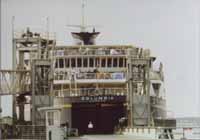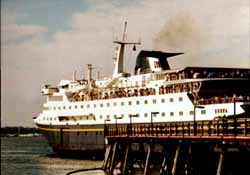The World Wide Web:
Cyber Chaos or Learning Journey?
by Wilma Kurvink
wilmaedd@bluep.com
|

|
What contribution can the Internet make to the curriculum?
Can we harness its power and turn it to our educational advantage?
Information Super Highway, or Electronic Junk Mail?
A colleague of mine lamented how overrated the Internet was . . .
- It's just a collection of brochures and useless unreliable stuff; it doesn’t compare to books and articles.
Michael Gorman agrees :
- The net is like a huge vandalised library... someone has destroyed the catalogue....surfing the net is sifting through this disorganised mess in the hope of coming across fragments of text and images.1
Then what about the perceived lack of publishing standards on the Web, and the authority of information ?
Teachers using the Internet with students know that issue can present difficulties, and they express reservations about an information source that can be so uncontrolled and diverse. We may admire the vast riches of information in the Federal Parliament site and yet deplore the shabby commercialism which permeates the Web. What about the unbridled promotion of company products masquerading as genuine information hardly distinguishable from a genuine piece of research? Is it so readily discerned by students?
Technology Advances and Web Pervasiveness
Traditional information services such databases, indexes and abstracting services are online and expanding. Standard reference tools like CD-ROM encyclopedias are linked to online services, pointing to an implicit acceptance of the Web as an information tool.
Multi tasking and seamless interfaces through our computer operating systems mean students may not be distinguishing between these programs and the Internet as they may have a year or two ago. One click from Encarta can take you straight to a Web site. Will a student know the difference? If the action from going from one information source to another is almost instantaneous, we must then be more vigilant as educators to ensure our students are aware of the contexts of information.
Our Dilemma: Not Whether We Use the Internet, but How.
We need to redefine our role as educators in relation to the new dissemination of information and all that has come along with it.
Moreover, we need to empower students with critical literacy and information skills. Students who develop these skills can devise a search strategy, evaluate a resource, determine authorship, question validity, and make judgements about the appropriateness and usefulness of information. In our college, learning how to use the Internet has led to collaboration between teacher and teacher librarian, and has resulted in a more sustained approach to information skills in our work with students.
Gilmore College for Girls
Internet Investigations and Evaluations
Recently our senior physics students were given a range of topics on nuclear energy: nuclear waste, radiation, nuclear power production. Sites we found with the students were: The Virtual Nuclear Power Plant Tour, reports on nuclear safety, a site designed for schools and students studying the physics of nuclear energy by a university, and sites detailing environmental effects of nuclear reactors. We found anti nuclear groups, and research undertaken by governments and medical departments.
Together with our students we established the validity and importance of individual sites. We also gained an overall picture of activity in the sphere of nuclear energy; of the industry, governments, activists and environmental groups.
Of special interest was the Virtual Nuclear Power Plant Tour by the American nuclear power industry. This comprehensive site illustrated the workings of a nuclear power plant. The information illustrating the concepts of nuclear power production was excellent. It also featured a chart of the relative merits and costs associated with the generation of traditional and alternative energy sources. Not surprisingly it declared nuclear energy was clean and efficient in comparison with coal, wind, solar and other forms of electricity generation!. Although the virtual demonstration of power production was valuable, students using this site needed to learn skills in evaluating the source and interpreting it.
Exploiting Diversity of Information
Diversity of Internet materials came to light when students were researching the eating disorder Bulimia. Sites varied; hospitals providing descriptions of symptoms and treatments, dental research sites recording damage to the teeth of sufferers, health organisations, and homepages of support groups. We compiled useful clinical information, and a comparison of the authors of the web sites again provided a comprehensive picture of activity at a government and medical level. The support groups published a range of texts that were useful and in particular those of sufferers who described their struggles and whose moving stories gave a personal dimension to the issue. Interpreting this information is an important part of making meaningful use of the Internet and is here that educators, teachers and teacher librarians have a crucial role to play. It offers that opportunity for mentoring and guidance.
Joining Forces on Information and Learning
Partnerships between teachers and teacher librarians can ensure we give students skills and guidance. Librarians can provide the interface between the information source and the users. They can locate information in advance and provide teachers with the scope of the topic as it is represented on the Web, and assist with strategies for locating the best of it. "Best" in this instance not only being authoritative information but also what is challenging and what is diverse.
Recently we looked for tourist destinations in Australia on the Web with year 7 students. The girls looking for the Great Barrier Reef were very pleased. Those looking for Broome in Western Australia found much less information. A small mention on a state government tourism page here and there, and one personal home page by a resident describing his lifestyle and listing his reasons for loving the town. Finally a mention of Broome as a place where average weather details were recorded - and that was about it! Discussing this with students raised issues about marketing and why some tourist sites were more heavily publicised than others and what the implications of this may be. It led us to a further discussion as to why the Internet may not be the source for information on out of the way places.
Learning Journeys
Our explorations of the Internet could be described as learning journeys as we capitalised on the picture of activity around the world, discovering and discussing these sites. We can harness the power of the Internet as an information source by exploiting this very diversity of publishing. We can use the range of viewpoints to illustrate fundamental concepts and the structures that regulate how we live.
Between the gems of sites such as the United Nations Homepage, the VICNET directory, and the commercial hype of Geocities, the Internet can offer us the dimensions of humanity with its flaws and biases. It can show us many faceted pictures of the human endeavours on our planet; scientific, artistic, commercial, and political. We can use the Web in this powerful way and for these very reasons can offer the development of conceptual understandings in our students. This learning journey is too good to miss!
References
1. Michael Gorman, "The Corruption of Cataloguing" Library Journal 120 ( September 15, 1995: 34)
2. James Rettig , "Putting the Squeeze on the Information fire hose: The need for ‘Neteditors’ and ‘Netretrievers’". paper presented 15th Annual Charleston Conference November 3 1995
Information skills processes-
Materials Available from School Library Association of Victoria;
Using the CSF to teach information skills; Strategies for the Key Learning Areas
RGM Access Information, School Library Association Victoria 1995
© October 1998
Wilma Kurvink
Gilmore College for Girls
Footscray
Australia
Credits: The photographs were shot by Jamie McKenzie.
Some were also modified with Photoshop.
Copyright Policy: Materials published in From Now On may be duplicated in hard copy format if unchanged in format and content for educational, nonprofit school district use only and may also be sent from person to person by e-mail. This copyright statement must be included. All other uses, transmissions and duplications are prohibited unless permission is granted expressly. Showing these pages remotely through frames is not permitted.
FNO is applying for formal copyright registration for articles.
|

 From Now On
From Now On


